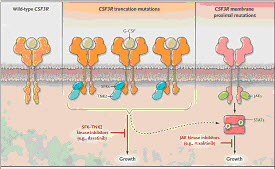罗氏:NimbleGen定制捕获芯片用于白血病亚型分子标记发现
| 导读 | 许多白血病的致病机制尚不清楚,其中慢性中性粒细胞白血病(Chronic Neutrophilic leukemia)及非典型慢性髓性白血病(BCR-ABL1-negative atypical Chronic Myeloid Leukemia)的诊断通常仅仅基于粒细胞的恶性增殖,以不含有其他白血病的基因标记作为诊断标准,而缺乏对其本身驱动基因的认识。
近期在新英格兰杂志上发表的一篇文章1对这... |
许多白血病的致病机制尚不清楚,其中慢性中性粒细胞白血病(Chronic Neutrophilic leukemia)及非典型慢性髓性白血病(BCR-ABL1-negative atypical Chronic Myeloid Leukemia)的诊断通常仅仅基于粒细胞的恶性增殖,以不含有其他白血病的基因标记作为诊断标准,而缺乏对其本身驱动基因的认识。
近期在新英格兰杂志上发表的一篇文章1对这类白血病的分子机制进行的深入研究。作者对27例慢性中性粒细胞白血病以及非典型CML骨髓或血液样本进行了部分基因定向高深度测序,分析基因突变的情况,发现一个基因CSF3R的突变在这个类群病人中尤其常见。而CSF3R基因的功能正是细胞生长因子的受体,可以刺激中性粒细胞分化和增殖,这与这类病人的临床表型一致。
同时对病人分离的肿瘤细胞进行tyrosine kinase–specific small interfering RNAs 或 small-molecule kinase inhibitors筛选实验。对于突变进行体外细胞转化实验验证,并用原始细胞克隆进行药敏试验。这些实验验证了这一基因的突变改变下游信号通路,也可造成细胞的增殖。药敏试验也证实了该基因的多种突变可对不同的下游通路中的抑制剂敏感,尤其一个病人在接受相应的抑制剂治疗后临床症状得到改善。作者认为,CSF3R突变在CNL及atypical CML的常见,而在其他白血病亚型中相对罕见,可用于慢性中性粒细胞白血病及非典型慢性髓性白血病白血病分型的重要分子诊断参考。
在CSF3R基因突变的发现过程中,主要利用NimbleGen的定制型序列捕获芯片,对1683个基因的外显子序列进行富集后,再进行二代测序仪进行深度测序。突变分析结果中,这一病人群体中的59%携带CSF3R突变,可活化这一受体,突变主要分布在CSF3R的两个独立区域内,分别导致CSF3R下游的SRC family-TNK2或者JAK Kinase的活化。

图:显示不同CSF3R基因突变对于细胞通路的影响。
随着生物技术的发展,将为越来越多疾病的致病机制探索提供更加有效地手段,其中之一是利用高深度的定向测序方法寻找疾病相关基因。通过NimbleGen 序列捕获芯片,可对人类全外显子组序列,或者所感兴趣的部分基因进行高效富集,衔接二代测序,可以更加经济有效地进行研究工作,同时也减少的数据分析的压力,这方法已经为国内外越来越多的研究人员所采用。
原文链接:
Oncogenic CSF3R mutations in chronic neutrophilic leukemia and atypical CML
BACKGROUND: The molecular causes of many hematologic cancers remain unclear. Among these cancers are chronic neutrophilic leukemia (CNL) and atypical (BCR-ABL1-negative) chronic myeloid leukemia (CML), both of which are diagnosed on the basis of neoplastic expansion of granulocytic cells and exclusion of genetic drivers that are known to occur in other myeloproliferative neoplasms and myeloproliferative-myelodysplastic overlap neoplasms.
METHODS: To identify potential genetic drivers in these disorders, we used an integrated approach of deep sequencing coupled with the screening of primary leukemia cells obtained from patients with CNL or atypical CML against panels of tyrosine kinase-specific small interfering RNAs or small-molecule kinase inhibitors. We validated candidate oncogenes using in vitro transformation assays, and drug sensitivities were validated with the use of assays of primary-cell colonies.
RESULTS: We identified activating mutations in the gene encoding the receptor for colony-stimulating factor 3 (CSF3R) in 16 of 27 patients (59%) with CNL or atypical CML. These mutations segregate within two distinct regions of CSF3R and lead to preferential downstream kinase signaling through SRC family-TNK2 or JAK kinases and differential sensitivity to kinase inhibitors. A patient with CNL carrying a JAK-activating CSF3R mutation had marked clinical improvement after the administration of the JAK1/2 inhibitor ruxolitinib.
CONCLUSIONS: Mutations in CSF3R are common in patients with CNL or atypical CML and represent a potentially useful criterion for diagnosing these neoplasms. (Funded by the Leukemia and Lymphoma Society and others.).

来源:Roche
近期在新英格兰杂志上发表的一篇文章1对这类白血病的分子机制进行的深入研究。作者对27例慢性中性粒细胞白血病以及非典型CML骨髓或血液样本进行了部分基因定向高深度测序,分析基因突变的情况,发现一个基因CSF3R的突变在这个类群病人中尤其常见。而CSF3R基因的功能正是细胞生长因子的受体,可以刺激中性粒细胞分化和增殖,这与这类病人的临床表型一致。
同时对病人分离的肿瘤细胞进行tyrosine kinase–specific small interfering RNAs 或 small-molecule kinase inhibitors筛选实验。对于突变进行体外细胞转化实验验证,并用原始细胞克隆进行药敏试验。这些实验验证了这一基因的突变改变下游信号通路,也可造成细胞的增殖。药敏试验也证实了该基因的多种突变可对不同的下游通路中的抑制剂敏感,尤其一个病人在接受相应的抑制剂治疗后临床症状得到改善。作者认为,CSF3R突变在CNL及atypical CML的常见,而在其他白血病亚型中相对罕见,可用于慢性中性粒细胞白血病及非典型慢性髓性白血病白血病分型的重要分子诊断参考。
在CSF3R基因突变的发现过程中,主要利用NimbleGen的定制型序列捕获芯片,对1683个基因的外显子序列进行富集后,再进行二代测序仪进行深度测序。突变分析结果中,这一病人群体中的59%携带CSF3R突变,可活化这一受体,突变主要分布在CSF3R的两个独立区域内,分别导致CSF3R下游的SRC family-TNK2或者JAK Kinase的活化。

图:显示不同CSF3R基因突变对于细胞通路的影响。
原文链接:
Oncogenic CSF3R mutations in chronic neutrophilic leukemia and atypical CML
BACKGROUND: The molecular causes of many hematologic cancers remain unclear. Among these cancers are chronic neutrophilic leukemia (CNL) and atypical (BCR-ABL1-negative) chronic myeloid leukemia (CML), both of which are diagnosed on the basis of neoplastic expansion of granulocytic cells and exclusion of genetic drivers that are known to occur in other myeloproliferative neoplasms and myeloproliferative-myelodysplastic overlap neoplasms.
METHODS: To identify potential genetic drivers in these disorders, we used an integrated approach of deep sequencing coupled with the screening of primary leukemia cells obtained from patients with CNL or atypical CML against panels of tyrosine kinase-specific small interfering RNAs or small-molecule kinase inhibitors. We validated candidate oncogenes using in vitro transformation assays, and drug sensitivities were validated with the use of assays of primary-cell colonies.
RESULTS: We identified activating mutations in the gene encoding the receptor for colony-stimulating factor 3 (CSF3R) in 16 of 27 patients (59%) with CNL or atypical CML. These mutations segregate within two distinct regions of CSF3R and lead to preferential downstream kinase signaling through SRC family-TNK2 or JAK kinases and differential sensitivity to kinase inhibitors. A patient with CNL carrying a JAK-activating CSF3R mutation had marked clinical improvement after the administration of the JAK1/2 inhibitor ruxolitinib.
CONCLUSIONS: Mutations in CSF3R are common in patients with CNL or atypical CML and represent a potentially useful criterion for diagnosing these neoplasms. (Funded by the Leukemia and Lymphoma Society and others.).

来源:Roche
 腾讯登录
腾讯登录
还没有人评论,赶快抢个沙发